Eclipse basics
Will you be in the eclipse’s path on April 8? Consult our viewing guide to see where, when and how to see it, and share your science questions for reporter Ivan Semeniuk to answer.
The first time I was fully immersed in the moon’s shadow was also the last time a total eclipse carved a path across Canada.
It was Feb. 26, 1979. I was 14 and one of about 100 shivering members of the Royal Astronomical Society of Canada who had just been delivered by chartered plane to a windswept airstrip in Gimli, Man.
Forty-five years on, you would think the memory of that day would have faded somewhat. But what I saw – what I experienced for the first time as the sun disappeared behind the moon’s advancing silhouette – was unforgettable.
It also prompted my first piece of science journalism, when I wrote about the eclipse for my local newspaper, The Amherstburg Echo. Today, the yellowed clipping I saved still evokes the breathless spectacle of it all. “There in the dark sky was a large, pitch black disk,” the younger me reported. “Surrounding it, the sun’s corona, or outer atmosphere, now brightly visible, shimmered like a ghostly veil.”

Shortly after 1979's eclipse, members of the Royal Astronomical Society of Canada savour the experience at the airstrip in Gimli, Man.Michael Waston
I wasn’t the only one struggling for superlatives. The late Canadian astronomy author Terence Dickinson was also at Gimli. In his bestselling stargazing manual, Nightwatch, he wrote: “I was completely unprepared for the overwhelming power of the eclipse.”
Exactly two minutes and 48 seconds later, it was over and around me everyone seemed to share the same thought: That was incredible – when is the next one?
In the decades that followed, I managed to witness a few more of these events, reliving my Gimli experience in Mexico, Turkey and Tennessee. But never in Canada.
Not until now.
Whenever I’ve reported on future solar eclipses, there’s always been one date that tops my list. April 8, 2024, is the big one. On that day – weather permitting – more Canadians will have a chance to see a total eclipse of the sun on their home turf than at any previous time in history.
For those who stood on the tarmac at Gimli, or elsewhere in the path of the 1979 event, April’s spectacle will bookend a decades-long fascination. For those who have never seen a total eclipse of the sun, this could be the start of a new obsession.

Total eclipse times and durations for
selected Canadian locations
(local times, p.m.)
ONT.
North
100 km
Toronto
Durations
30 seconds
U.S.
Hamilton
1 minute
Windsor
2 minutes
Niagara
Falls
3 minutes
Leamington
3:20
Central line
3:18
3:16
3:14 p.m.
(EDT)
Ottawa
Cornwall
Kingston
3:26
3:24
3:22 p.m.
(EDT)
PARTIAL
TOTAL
DURATION
PARTIAL
ECLIPSE
ECLIPSE
OF
ECLIPSE
BEGINS
BEGINS
TOTALITY
ENDS
Ontario
Leamington
1:58:39
3:13:43
2m 2s
4:28:04
Hamilton
2:03:56
3:18:12
1m 53s
4:31:12
Niagara Falls
2:04:53
3:18:20
3m 30s
4:32:00
Fort Erie
2:04:47
3:18:12
3m 44s
4:32:02
Kingston
2:09:32
3:22:16
3m 2s
4:34:28
Cornwall
2:12:35
3:25:01
2m 11s
4:35:58
North
Quebec
100 km
QUE.
Montreal
Lac-Mégantic
3:32
3:30
3:28 p.m.
(EDT)
PARTIAL
TOTAL
DURATION
PARTIAL
ECLIPSE
ECLIPSE
OF
ECLIPSE
BEGINS
BEGINS
TOTALITY
ENDS
Quebec
Montreal
2:14:29
3:26:55
1m 17s
4:36:52
Drummondville
2:16:07
3:28:32
35s
4:37:40
Sherbrooke
2:16:37
3:27:43
3m 25s
4:38:16
Lac-Mégantic
2:18:01
3:28:47
3m 27s
4:38:58
North
100 km
N.B.
Grand Falls
Les Îles-de-la-Madeleine
4:34 p.m.
(ADT)
4:36
4:40
Tignish
Fredericton
PEI
Moncton
Charlottetown
PARTIAL
TOTAL
DURATION
PARTIAL
ECLIPSE
ECLIPSE
OF
ECLIPSE
BEGINS
BEGINS
TOTALITY
ENDS
New Brunswick
Grand Falls
3:22:45
4:33:06
1m 27s
5:40:49
Hartland
3:22:43
4:32:24
3m 21s
5:43:13
Fredericton
3:23:43
4:33:50
2m 16s
5:41:55
Miramichi
3:25:27
4:34:24
3m 09s
5:42:15
Prince Edward Island
Tignish
3:27:12
4:35:45
3m 11s
5:43:10
Summerside
3:27:23
4:37:08
1m 04s
5:43:32
North
100 km
N.L.
Gander
5:14 p.m.
(NDT)
Bonavista
5:18
Clarenville
Channel-Port
Aux Basques
PARTIAL
TOTAL
DURATION
PARTIAL
ECLIPSE
ECLIPSE
OF
ECLIPSE
BEGINS
BEGINS
TOTALITY
ENDS
Newfoundland and Labrador
Channel-Port
4:02:52
5:09:59
2m 45s
6:15:26
Aux Basques
Gander
4:07:27
5:12:50
2m 13s
6:16:29
Clarenville
4:08:11
5:13:38
2m 31s
6:17:11
Bonavista
4:08:52
5:13:43
2m 53s
6:17:07
MURAT YÜKSELIR / THE GLOBE AND MAIL, SOURCE:
NASA; OPENSTREETMAP; FRED ESPENAK,
RASC OBSERVER’S HANDBOOK

Total eclipse times and durations for
selected Canadian locations
(local times, p.m.)
ONT.
North
100 km
Toronto
Durations
30 seconds
U.S.
Hamilton
1 minute
Windsor
2 minutes
Niagara
Falls
3 minutes
Leamington
3:20
Central line
3:18
3:16
3:14 p.m.
(EDT)
Ottawa
Cornwall
Kingston
3:26
3:24
3:22 p.m.
(EDT)
PARTIAL
TOTAL
DURATION
PARTIAL
ECLIPSE
ECLIPSE
OF
ECLIPSE
BEGINS
BEGINS
TOTALITY
ENDS
Ontario
Leamington
1:58:39
3:13:43
2m 2s
4:28:04
Hamilton
2:03:56
3:18:12
1m 53s
4:31:12
Niagara Falls
2:04:53
3:18:20
3m 30s
4:32:00
Fort Erie
2:04:47
3:18:12
3m 44s
4:32:02
Kingston
2:09:32
3:22:16
3m 2s
4:34:28
Cornwall
2:12:35
3:25:01
2m 11s
4:35:58
North
Quebec
100 km
QUE.
Montreal
Lac-Mégantic
3:32
3:30
3:28 p.m.
(EDT)
PARTIAL
TOTAL
DURATION
PARTIAL
ECLIPSE
ECLIPSE
OF
ECLIPSE
BEGINS
BEGINS
TOTALITY
ENDS
Quebec
Montreal
2:14:29
3:26:55
1m 17s
4:36:52
Drummondville
2:16:07
3:28:32
35s
4:37:40
Sherbrooke
2:16:37
3:27:43
3m 25s
4:38:16
Lac-Mégantic
2:18:01
3:28:47
3m 27s
4:38:58
North
100 km
N.B.
Grand Falls
Les Îles-de-la-Madeleine
4:34 p.m.
(ADT)
4:36
4:40
Tignish
Fredericton
PEI
Moncton
Charlottetown
PARTIAL
TOTAL
DURATION
PARTIAL
ECLIPSE
ECLIPSE
OF
ECLIPSE
BEGINS
BEGINS
TOTALITY
ENDS
New Brunswick
Grand Falls
3:22:45
4:33:06
1m 27s
5:40:49
Hartland
3:22:43
4:32:24
3m 21s
5:43:13
Fredericton
3:23:43
4:33:50
2m 16s
5:41:55
Miramichi
3:25:27
4:34:24
3m 09s
5:42:15
Prince Edward Island
Tignish
3:27:12
4:35:45
3m 11s
5:43:10
Summerside
3:27:23
4:37:08
1m 04s
5:43:32
North
100 km
N.L.
Gander
5:14 p.m.
(NDT)
Bonavista
5:18
Clarenville
Channel-Port
Aux Basques
PARTIAL
TOTAL
DURATION
PARTIAL
ECLIPSE
ECLIPSE
OF
ECLIPSE
BEGINS
BEGINS
TOTALITY
ENDS
Newfoundland and Labrador
Channel-Port
4:02:52
5:09:59
2m 45s
6:15:26
Aux Basques
Gander
4:07:27
5:12:50
2m 13s
6:16:29
Clarenville
4:08:11
5:13:38
2m 31s
6:17:11
Bonavista
4:08:52
5:13:43
2m 53s
6:17:07
MURAT YÜKSELIR / THE GLOBE AND MAIL, SOURCE:
NASA; OPENSTREETMAP; FRED ESPENAK,
RASC OBSERVER’S HANDBOOK
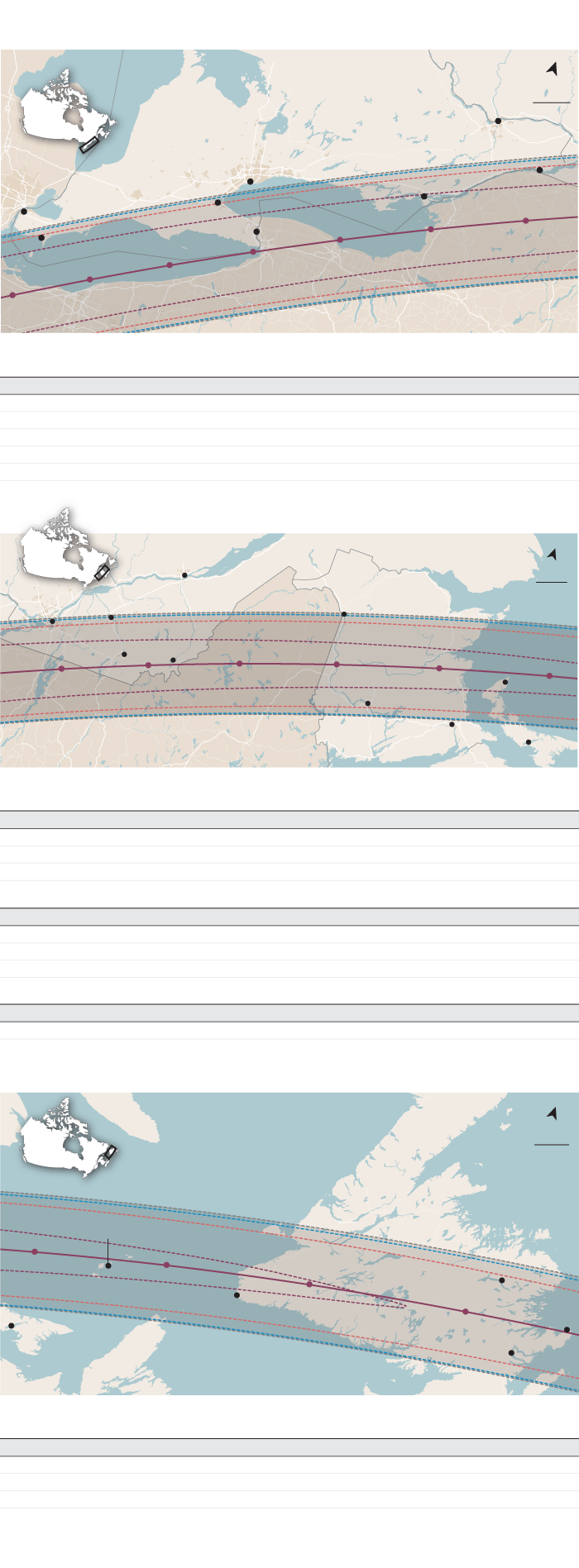
Total eclipse times and durations for selected Canadian locations
(local times, p.m.)
North
50 km
CANADA
Ottawa
ONT.
Cornwall
Toronto
Durations
30 seconds
U.S.
Kingston
1 minute
Hamilton
Windsor
2 minutes
3 minutes
3:26
Niagara Falls
Leamington
3:24
3:22
3:20
Central line
3:18
3:16
3:14 p.m.
(EDT)
PARTIAL
TOTAL
PARTIAL
ECLIPSE
ECLIPSE
DURATION OF
ECLIPSE
BEGINS
BEGINS
TOTALITY
ENDS
Ontario
Leamington
1:58:39
3:13:43
2m 2s
4:28:04
Hamilton
2:03:56
3:18:12
1m 53s
4:31:12
Niagara Falls
2:04:53
3:18:20
3m 30s
4:32:00
Fort Erie
2:04:47
3:18:12
3m 44s
4:32:02
Kingston
2:09:32
3:22:16
3m 2s
4:34:28
Cornwall
2:12:35
3:25:01
2m 11s
4:35:58
North
Quebec
50 km
QUE.
N.B.
Montreal
Grand
Falls
Drummondville
Lac-Mégantic
Sherbrooke
3:32
4:34 p.m.
(AST)
3:30
4:36
3:28 p.m.
(EDT)
Tignish
Fredericton
PEI
Moncton
Charlottetown
PARTIAL
TOTAL
PARTIAL
ECLIPSE
ECLIPSE
DURATION OF
ECLIPSE
BEGINS
BEGINS
TOTALITY
ENDS
Quebec
Montreal
2:14:29
3:26:55
1m 17s
4:36:52
Drummondville
2:16:07
3:28:32
35s
4:37:40
Sherbrooke
2:16:37
3:27:43
3m 25s
4:38:16
Lac-Mégantic
2:18:01
3:28:47
3m 27s
4:38:58
New Brunswick
Grand Falls
3:22:45
4:33:06
1m 27s
5:40:49
Hartland
3:22:43
4:32:24
3m 21s
5:43:13
Fredericton
3:23:43
4:33:50
2m 16s
5:41:55
Miramichi
3:25:27
4:34:24
3m 09s
5:42:15
Prince Edward Island
Tignish
3:27:12
4:35:45
3m 11s
5:43:10
Summerside
3:27:23
4:37:08
1m 04s
5:43:32
North
50 km
Les Îles-de-la-Madeleine
4:40 p.m.
(ADT)
4:42
N.L.
Gander
5:14 p.m.
(NDT)
Channel-Port
aux Basques
5:18
Charlottetown
Bonavista
Clarenville
N.S.
PARTIAL
TOTAL
PARTIAL
ECLIPSE
ECLIPSE
DURATION OF
ECLIPSE
BEGINS
BEGINS
TOTALITY
ENDS
Newfoundland and Labrador
Channel-Port Aux Basques
4:02:52
5:09:59
2m 45s
6:15:26
Gander
4:07:27
5:12:50
2m 13s
6:16:29
Clarenville
4:08:11
5:13:38
2m 31s
6:17:11
Bonavista
4:08:52
5:13:43
2m 53s
6:17:07
MURAT YÜKSELIR / THE GLOBE AND MAIL, SOURCE: NASA; OPENSTREETMAP; FRED ESPENAK, RASC OBSERVER’S HANDBOOK
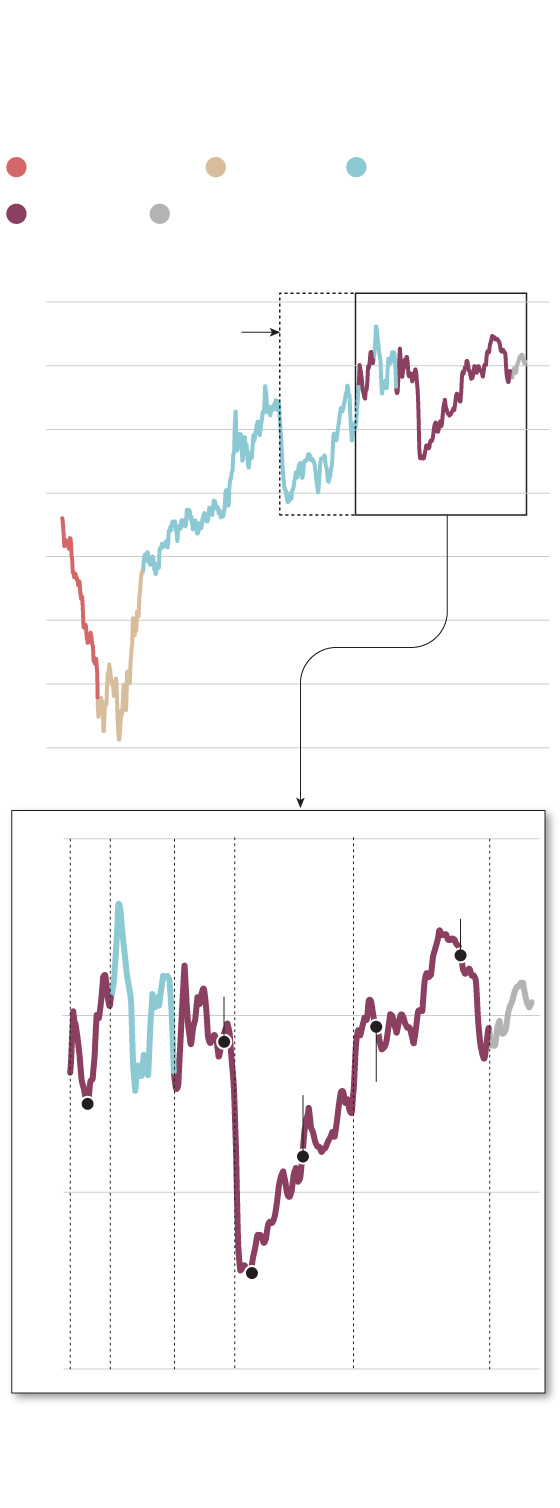
Eclipse weather prospects
Average frequency of April cloud cover along the central line of the 2024 total eclipse
Pacific Ocean
Mexico
U.S.
Canada
Atlantic Ocean
90%
Path of total
eclipse partly
in Ontario
80
70
60
50
40
30
20
90%
Que.
Maine
N.B.
Que. and
Gulf of Saint
Lawrence
N.L.
Gander
Miramichi
80
Îles de la
Madeleine
Stephenville
Sherbrooke
70
Tignish
60
THE GLOBE AND MAIL, SOURCE:
NASA; JAY ANDERSON
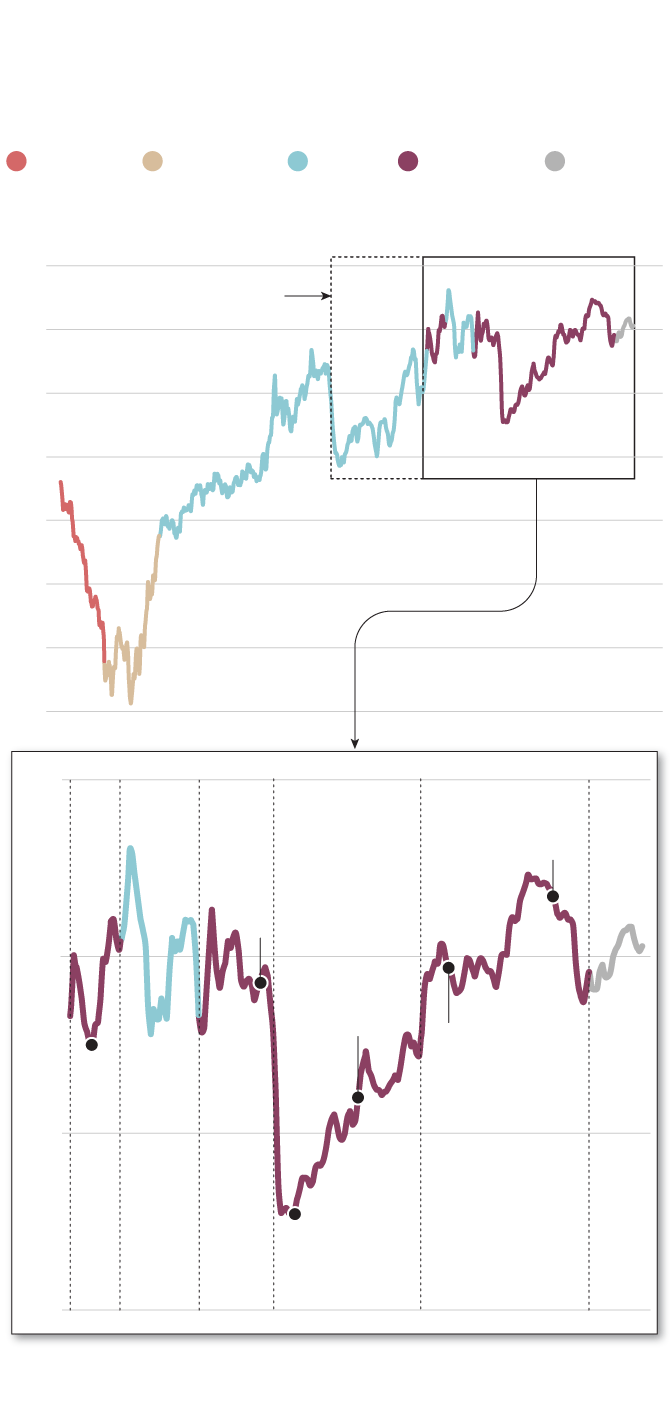
Eclipse weather prospects
Average frequency of April cloud cover along the central line of the 2024 total eclipse
Pacific
Ocean
Mexico
U.S.
Canada
Atlantic
Ocean
90%
Path of total
eclipse partly
in Ontario
80
70
60
50
40
30
20
90%
Que.
Maine
N.B.
Que. and
Gulf of Saint
Lawrence
N.L.
Gander
Miramichi
80
Îles de la
Madeleine
Stephenville
Sherbrooke
70
Tignish
60
THE GLOBE AND MAIL, SOURCE: NASA; JAY ANDERSON
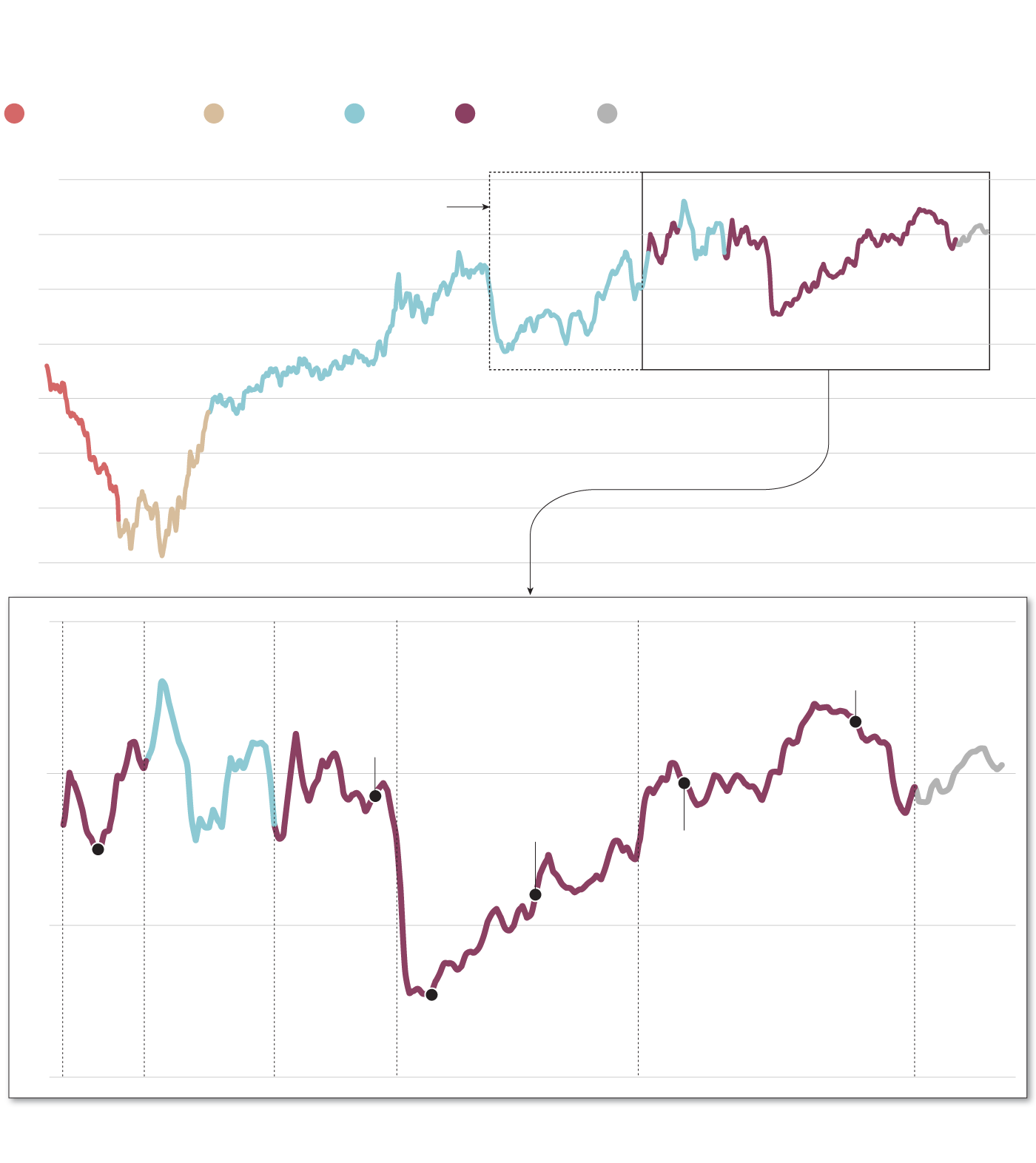
Eclipse weather prospects
Average frequency of April cloud cover along the central line of the 2024 total eclipse
Pacific Ocean
Mexico
U.S.
Canada
Atlantic Ocean
90%
Path of total
eclipse partly
in Ontario
80
70
60
50
40
30
20
90%
Que.
Maine
N.B.
Que. and
Gulf of Saint
Lawrence
N.L.
Gander
Miramichi
80
Îles de la
Madeleine
Stephenville
Sherbrooke
70
Tignish
60
THE GLOBE AND MAIL, SOURCE: NASA; JAY ANDERSON
Jay Anderson, an expert on weather conditions during eclipses, reckons he has now seen about 25 “totals.” He, too, got his start in 1979.
Back then, Mr. Anderson was a junior forecaster working for Environment Canada in Winnipeg when he headed north to position himself in the path of the eclipse near Lake Manitoba. But his plan to create a series of photos during totality was thwarted when, in his excitement, he kicked loose a power cord that stopped the motor guiding his telescope. It proved to be a blessing. “It forced me to observe it more than to photograph it,” Mr. Anderson said.
Seasoned eclipse chasers often recommend the same to first-timers: Don’t worry about taking pictures. Just watch and try to remember what you see in the few minutes available. You won’t regret it.
What makes total eclipses of the sun so compelling? The answer is more emotional than scientific. At no other time does our direct experience of nature so thoroughly connect us to the rest of the solar system.
The sheer coincidence of it is equally mind-boggling. The sun is 400 times bigger than the moon and, by chance, about 400 times farther away. This means the moon appears to be about the same size as the sun in the sky. When things line up just right, the moon can cover the sun completely. On average, such heavenly alignments can be seen somewhere on Earth about five times a decade. But you can go a lifetime and never have one happen anywhere near you.
After 1979, Canada’s next total eclipse was seen by almost no one in the country, as it brushed over the high Arctic in August, 2008. Many more Canadians travelled south in 2017 to see a total eclipse that crossed the continental United States from west to east. That event, viewed by millions, is a good guide for what to expect on April 8.



If the weather co-operates, the few minutes during which the sun is totally eclipsed are certain to be dramatic.
At such times, the sky darkens enough to allow bright stars and planets to appear. Off to the side, the perimeter of the moon’s shadow creates a sunset glow on every horizon.
But the real attention-getter is the black circle in the sky rimmed with white, brushlike streamers. This is the million-degree sheath of ionized particles that forms the sun’s corona and is normally hidden by the glaring brightness of the daytime sky.
Additionally, if there are solar prominences – giant tongues of hot plasma erupting from the sun’s surface – they can shine with ruby-red intensity at the inner edge of the corona.
In recent years, digital photography has made it easier to document these sights. But no camera can capture all the subtleties available to the human eye, or truly reproduce what it’s like to see a total eclipse live.
Proper eye protection is essential for the partial phases of the eclipse leading up to and after totality. But during the brief interval when the sun is entirely hidden and the corona appears, the eclipse can be witnessed safely with the naked eye.

To view an eclipse safely, spectators need special glasses like these ones waiting to be shipped from a store in Springdale, Ark. Regular sunglasses, no matter how dark, are not enough to block eye-damaging infrared rays. If in doubt, check with the American Astronomical Society's list of reputable suppliers.Michael Woods/The Associated Press

Solar eclipse safety
Never observe the sun...
...directly
...through
binoculars, cameras,
smartphones
or telescopes
...through
coloured
plastic or
glass
....through
sunglasses
...in a reflective
surface like a
mirror, water
or chrome
...through a
film negative
DIY: Binocular projection
Set the focus knob of your binoculars to the middle range
Use binoculars to project two identical images of the sun onto a white surface about 30 cm away
To avoid overheating your binoculars don’t point them at the sun for more than a few minutes at a time
THE GLOBE AND MAIL

Solar eclipse safety
Never observe the sun...
...directly
...through binoculars,
cameras, smartphones
or telescopes
...through
coloured
plastic or
glass
....through
sunglasses
...in a reflective
surface like a
mirror, water
or chrome
...through a
film negative
DIY: Binocular projection
Set the focus knob of your binoculars to the middle range
Use binoculars to project two identical images of the sun onto a white surface about 30 cm away
To avoid overheating your binoculars don’t point them at the sun for more than a few minutes
at a time
THE GLOBE AND MAIL

Solar eclipse safety
Never observe the sun...
DIY: Binocular projection
...directly
...through binoculars,
cameras, smartphones
or telescopes
....through
sunglasses
...in a reflective surface
like a mirror, water
or chrome
Set the focus knob of your binoculars to the middle range
Use binoculars to project two identical images of the sun onto a white surface about 30 cm away
To avoid overheating your binoculars don’t point them at the sun for more than a few minutes at a time
...through coloured
plastic or glass
...through a
film negative
THE GLOBE AND MAIL
For locations just outside the path of totality – including in Toronto, Canada’s largest urban centre – the day will bring a deep partial eclipse in which the sun is about 99-per-cent obscured. This is similar to what was seen in May, 1994, when parts of Southern Ontario and Atlantic Canada were treated to an annular eclipse of the sun. At such times, the moon is slightly farther away than average and too small to cover the sun completely.
But when it comes to solar eclipses, the difference between a total and almost total is literally night and day.
In many locations, public viewings are planned to facilitate the experience. The Royal Astronomical Society has been listing eclipse events across the country – including a live outdoor concert in Niagara Falls, public programs at Quebec’s Mont-Mégantic Observatory and an EclipseFest in Fredericton’s Odell Park among others.
But the eclipse can equally be savoured in small groups.
“You don’t need to be an astronomer to marvel at a total solar eclipse, any more than you need to be a geologist to enjoy the Grand Canyon,” said Victoria Kramkowski, who co-chairs the society’s eclipse task force and has been working with communities preparing for the event.
“Total eclipses are for anyone who wants to experience beauty, power and awe here on Earth,” Dr. Kramkowski added. “If you’re a human, a total eclipse is for you.”
If you’re wondering when Canadians will get another such opportunity at home, the new answer is 2044.
Best not to wait.
Space is the place: More from The Globe and Mail
Video: What will animals do during the eclipse?
More from science reporter Ivan Semeniuk
NASA scientists liberate asteroid sample – and tally Canada’s share
Did Earth once have a 19-hour day? A debate over the answer may illuminate the history of life
Shoot for the moon with The Globe’s 2023 science quiz
What do you want to know about the solar eclipse?
Globe science reporter Ivan Semeniuk is answering all your questions ahead of the April 8 solar eclipse. What is the path of totality? How can I watch it safely? How long will it last? Leave your questions below.

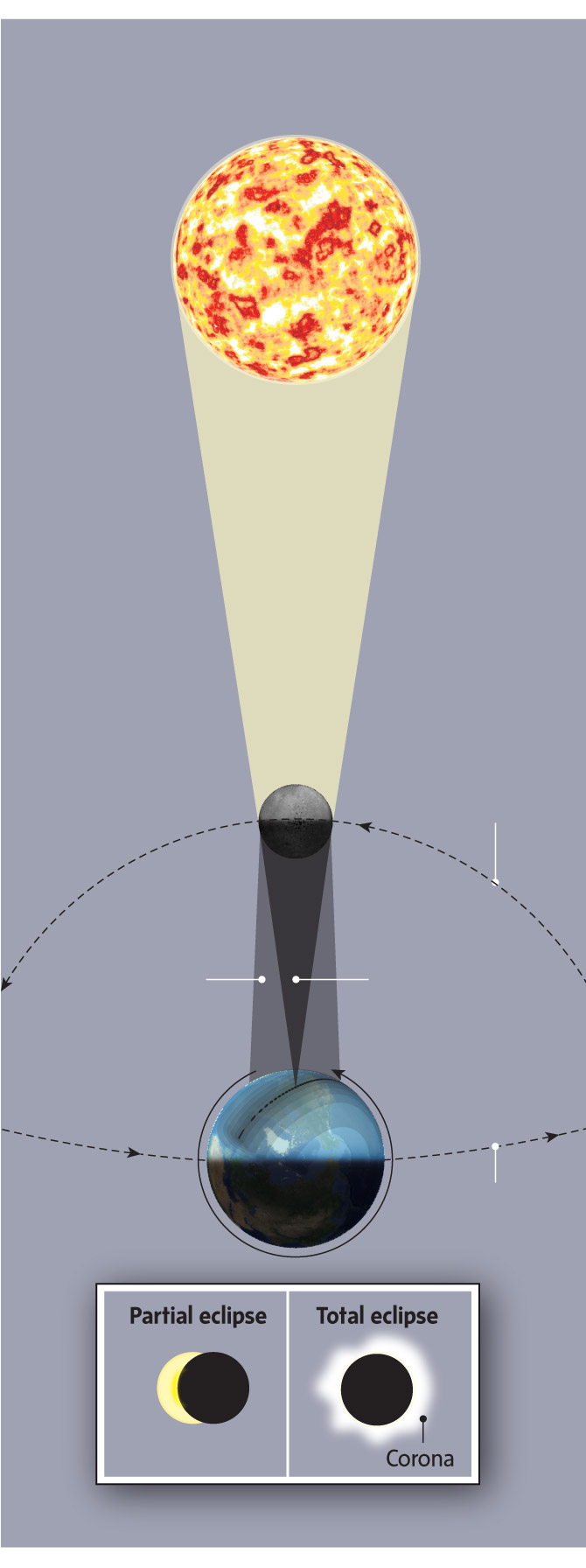
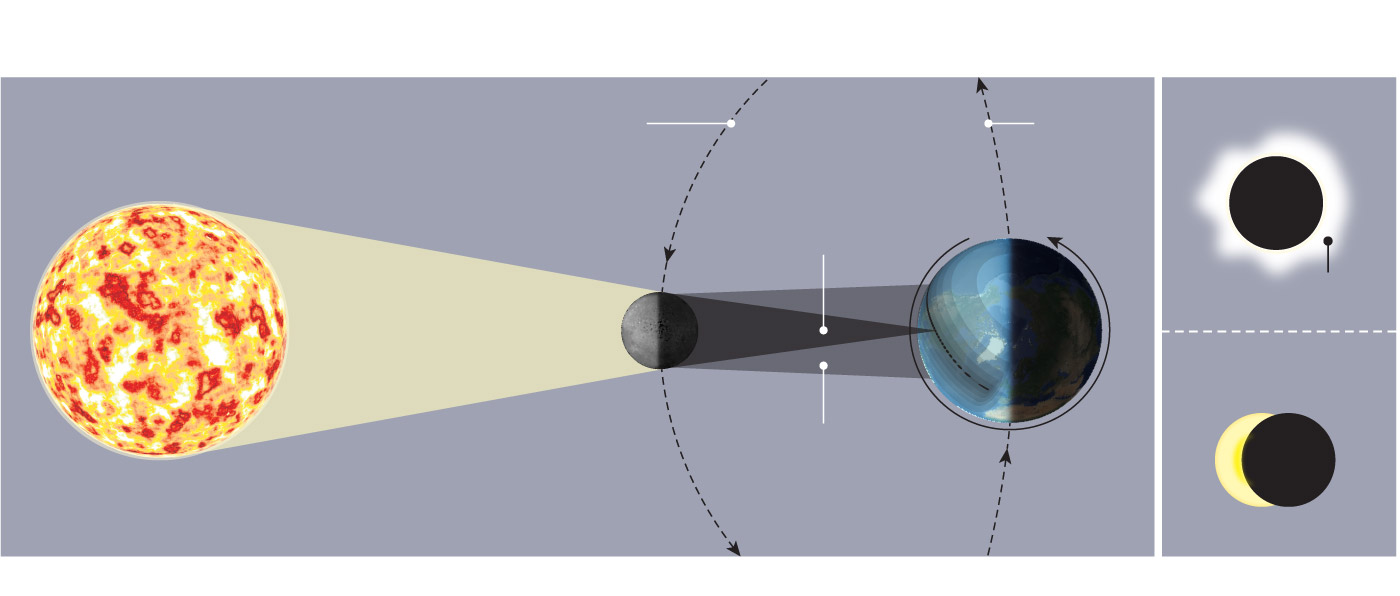
 Ivan Semeniuk
Ivan Semeniuk